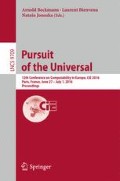Abstract
Molecular evolutionary methods and tools are difficult to validate as we have almost no direct access to ancient molecules. Inference methods may be tested with simulated data, producing full scenarios they can be compared with. But often simulations design is concomitant with the design of a particular method, developed by a same team, based on the same assumptions, when both should be blind to each other. In silico experimental evolution consists in evolving digital organisms with the aim of testing or discovering complex evolutionary processes. Models were not designed with a particular inference method in mind, only with basic biological principles. As such they provide a unique opportunity to blind test the behavior of inference methods. We give a proof of this concept on a comparative genomics problem: inferring the number of inversions separating two genomes. We use Aevol, an in silico experimental evolution platform, to produce benchmarks, and show that most combinatorial or statistical estimators of the number of inversions fail on this dataset while they were behaving perfectly on ad-hoc simulations. We argue that biological data is probably closer to the difficult situation.
Access this chapter
Tax calculation will be finalised at checkout
Purchases are for personal use only
References
Alexeev, N., Aidagulov, R., Alekseyev, M.A.: A computational method for the rate estimation of evolutionary transpositions. In: Ortuño, F., Rojas, I. (eds.) IWBBIO 2015, Part I. LNCS, vol. 9043, pp. 471–480. Springer, Heidelberg (2015)
Alexeev, N., Alekseyev, M.A.: Estimation of the true evolutionary distance under the fragile breakage model. Arxiv (2015). http://arxiv.org/abs/1510.08002
Batut, B., Parsons, D.P., Fischer, S., Beslon, G., Knibbe, C.: In silico experimental evolution: a tool to test evolutionary scenarios. BMC Bioinformatics 14(S15), S11 (2013)
Beiko, R.G., Charlebois, R.L.: A simulation test bed for hypotheses of genome evolution. Bioinformatics 23(7), 825–831 (2007)
Berestycki, N., Durrett, R.: A phase transition in the random transposition random walk. Probab. Theory Relat. Fields 136, 203–233 (2006)
Berthelot, C., Muffato, M., Abecassis, J., Crollius, H.R.: The 3d organization of chromatin explains evolutionary fragile genomic regions. Cell Rep. 10(11), 1913–1924 (2015)
Biller, P., Guéguen, L., Tannier, E.: Moments of genome evolution by double cut-and-join. BMC Bioinform. 16(Suppl 14), S7 (2015)
Biller, P., Knibbe, C., Guéguen, L., Tannier, E.: Breaking good: accounting for the diversity of fragile regions for estimating rearrangement distances. Genome Biol. Evol. (2016, in press)
Caprara, A., Lancia, G.: Experimental and statistical analysis of sorting by reversals. In: Sankoff, D., Nadeau, J.H. (eds.) Comparative Genomics, pp. 171–183. Springer, Amsterdam (2000)
Dalquen, D.A., Anisimova, M., Gonnet, G.H., Dessimoz, C.: ALF-a simulation framework for genome evolution. Mol. Biol. Evol. 29(4), 1115–1123 (2012)
Duchemin, W., Daubin, V., Tannier, E.: Reconstruction of an ancestral yersinia pestis genome and comparison with an ancient sequence. BMC Genom. 16(Suppl 10), S9 (2015)
Eriksen, N., Hultman, A.: Estimating the expected reversal distance after a fixed number of reversals. Adv. Appl. Math. 32, 439–453 (2004)
Fertin, G., Labarre, A., Rusu, I., Tannier, E., Vialette, S.: Combinatorics of Genome Rearrangements. MIT Press, London (2009)
Fletcher, W., Yang, Z.: Indelible: a flexible simulator of biological sequence evolution. Mol. Biol. Evol. 26(8), 1879–1888 (2009)
Hall, B.G.: Simulating DNA coding sequence evolution with EvolveAGene 3. Mol. Biol. Evol. 25(4), 688–695 (2008)
Hannenhalli, S., Pevzner, P.A.: Transforming men into mice (polynomial algorithm for genomic distance problem). In: Proceedings of 36th Annual Symposium on Foundations of Computer Science (1995)
Hillis, D.M., Bull, J.J., White, M.E., Badgett, M.R., Molineux, I.J.: Experimental phylogenetics: generation of a known phylogeny. Science 255(5044), 589–592 (1992)
Hindré, T., Knibbe, C., Beslon, G., Schneider, D.: New insights into bacterial adaptation through in vivo and in silico experimental evolution. Nat. Rev. Microbiol. 10, 352–365 (2012)
Knibbe, C., Coulon, A., Mazet, O., Fayard, J.-M., Beslon, G.: A long-term evolutionary pressure on the amount of noncoding DNA. Mol. Biol. Evol. 24(10), 2344–2353 (2007)
Larget, B., Simon, D.L., Kadane, J.B.: On a Bayesian approach to phylogenetic inference from animal mitochondrial genome arrangements (with discussion). J. Roy. Stat. Soc. B 64, 681–693 (2002)
Lemaitre, C., Zaghloul, L., Sagot, M.-F., Gautier, C., Arneodo, A., Tannier, E., Audit, B.: Analysis of fine-scale mammalian evolutionary breakpoints provides new insight into their relation to genome organisation. BMC Genom. 10, 335 (2009)
Lin, Y., Moret, M.E.: Estimating true evolutionary distances under the DCJ model. Bioinformatics 24(13), i114–i122 (2008)
Mallo, D., De Oliveira Martins, L., Posada, D.: Simphy: phylogenomic simulation of gene, locus, and species trees. Syst Biol. 65, 334–344 (2016)
Steel, M., Penny, D.: Parsimony, likelihood, and the role of models in molecular phylogenetics. Mol. Biol. Evol. 17(6), 839–850 (2000)
Swenson, K.M., Marron, M., Earnest-DeYoung, J.V., Moret, B.M.E.: Approximating the true evolutionary distance between two genomes. J. Exp. Algorithmics 12, 3.5 (2008)
Szőllösi, G.J., Boussau, B., Abby, S.S., Tannier, E., Daubin, V.: Phylogenetic modeling of lateral gene transfer reconstructs the pattern and relative timing of speciations. Proc. Natl. Acad. Sci. U. S. A. 109(43), 17513–17518 (2012)
Acknowledgement
This work was funded by FAPESP grant 2013/25084-2 to PB, ANR-10-BINF-01-01 Ancestrome to ET and ICT FP7 European programme EVOEVO to CK and GB.
Author information
Authors and Affiliations
Corresponding author
Editor information
Editors and Affiliations
Rights and permissions
Copyright information
© 2016 Springer International Publishing Switzerland
About this paper
Cite this paper
Biller, P., Knibbe, C., Beslon, G., Tannier, E. (2016). Comparative Genomics on Artificial Life. In: Beckmann, A., Bienvenu, L., Jonoska, N. (eds) Pursuit of the Universal. CiE 2016. Lecture Notes in Computer Science(), vol 9709. Springer, Cham. https://doi.org/10.1007/978-3-319-40189-8_4
Download citation
DOI: https://doi.org/10.1007/978-3-319-40189-8_4
Published:
Publisher Name: Springer, Cham
Print ISBN: 978-3-319-40188-1
Online ISBN: 978-3-319-40189-8
eBook Packages: Computer ScienceComputer Science (R0)

